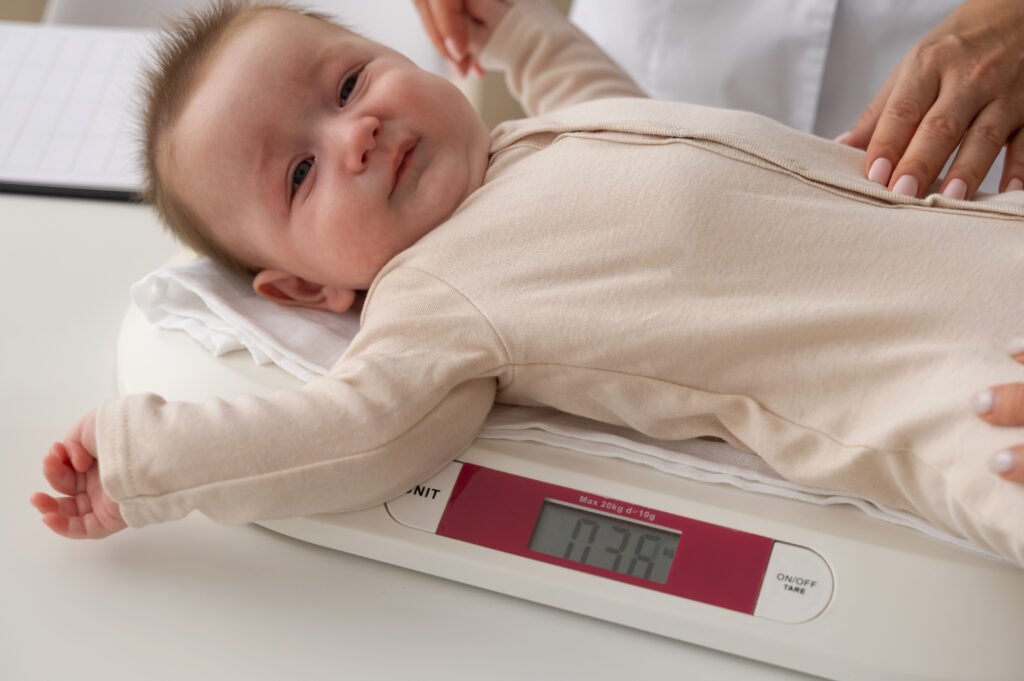Monitoring your baby’s weight is an essential aspect of infant care, providing valuable insights into their growth and development. While regular check-ups with a healthcare provider are crucial, weighing your baby at home can offer additional peace of mind and convenience. In this comprehensive guide, we’ll explore everything you need to know about how to weigh your baby at home safely and accurately. From choosing the right scale to interpreting the results, we’ll cover all the essentials to help you navigate this important aspect of infant care with confidence.
Choosing the Right Scale
The first step in weighing your baby at home is selecting the right scale for the job. There are two main types of scales suitable for weighing babies: digital baby scales and infant weighing baskets. Digital baby scales offer precise and accurate measurements, often featuring a flat surface for the baby to lie on and a digital display for easy reading. On the other hand, infant weighing baskets are portable and convenient, typically made of lightweight materials such as plastic or fabric.
When choosing a scale, consider factors such as accuracy, precision, ease of use, and portability. Opt for a scale that provides consistent and reliable measurements, ensuring that you can track your baby’s weight with confidence. Additionally, choose a scale that is easy to clean and maintain, as hygiene is essential when weighing infants. By selecting the right scale for your needs, you can ensure accurate and reliable measurements of your baby’s weight at home.
Preparing for the Weighing Process
Before weighing your baby at home, it’s essential to prepare a safe and comfortable environment for the procedure. Choose a flat and stable surface for the scale, such as a sturdy tabletop or the floor. Ensure proper lighting and temperature in the room to keep your baby calm and comfortable during the weighing process. Additionally, gather necessary supplies such as clean towels or blankets to provide a soft and supportive surface for your baby to lie on.
Once you have set up the weighing area, gather all the supplies you will need for the procedure, including your baby’s diaper and clothing. It’s essential to weigh your baby without bulky clothing or diapers that could affect the accuracy of the measurement. By preparing the environment and gathering necessary supplies beforehand, you can ensure a smooth and stress-free weighing experience for both you and your baby.
Weighing Techniques
When it comes to weighing your baby at home, there are two primary techniques you can use: using a digital baby scale or an infant weighing basket. Digital baby scales offer precise measurements and are relatively easy to use. To use a digital baby scale, start by placing the scale on a flat and stable surface. Calibrate the scale according to the manufacturer’s instructions and ensure it is zeroed out before weighing your baby.
Next, gently place your baby on the scale, making sure they are lying flat and still. Record the weight displayed on the digital display and note it down for future reference. Digital baby scales are ideal for parents who want accurate and reliable measurements of their baby’s weight at home.
Alternatively, you can use an infant weighing basket for weighing your baby at home. Infant weighing baskets are portable and convenient, making them suitable for use in various settings. To use an infant weighing basket, ensure the basket is clean and dry before placing your baby inside. Gently place your baby in the basket and record the weight displayed on the scale. Infant weighing baskets are a practical option for parents who want a lightweight and portable solution for weighing their baby at home.
Interpreting the Results
Once you’ve weighed your baby at home, it’s essential to interpret the results accurately to track their growth and development effectively. Understanding growth charts and percentiles can help you assess whether your baby’s weight is within the expected range for their age and gender. Plotting your baby’s weight on a growth chart allows you to visualize their growth trajectory and identify any trends or patterns over time.
Compare your baby’s weight to standard growth percentiles to determine how they measure up against their peers. Percentiles indicate the percentage of babies of the same age and gender who weigh the same or less than your baby. For example, if your baby’s weight falls within the 50th percentile, it means that they weigh more than 50% of babies of the same age and gender and less than the remaining 50%.
Additionally, be on the lookout for signs of healthy growth, such as consistent weight gain over time and adequate intake of breast milk or formula. If you have any concerns about your baby’s weight or growth, don’t hesitate to discuss them with your healthcare provider for further evaluation and guidance. By interpreting the results of your baby’s weight measurements accurately, you can ensure they are thriving and reaching their developmental milestones.
Troubleshooting and Tips
While weighing your baby at home can be a straightforward process, there may be times when you encounter challenges or difficulties. For example, some babies may become fussy or uncooperative during the weighing process, making it challenging to obtain accurate measurements. In such cases, it’s essential to remain calm and patient, and try soothing techniques to help your baby relax.
Engage in gentle rocking or swaying motions, sing soothing songs, or offer a pacifier to help calm your baby before attempting to weigh them. Timing the weighing process during a calm period, such as after a feeding or nap, can also increase the likelihood of success. Additionally, be prepared to try again later if your baby is not cooperating, as forcing the issue may only lead to further stress and frustration for both you and your baby.
To ensure accurate measurements, it’s important to follow proper weighing techniques and tips. Weigh your baby at the same time each day, preferably before or after a feeding when they are likely to be calm and content. Remove bulky clothing or diapers that could affect the accuracy of the measurement, and ensure the scale is properly calibrated and zeroed out before weighing your baby.
By troubleshooting common challenges and following these tips, you can increase the likelihood of a successful at-home weighing experience for you and your baby. Remember that patience and persistence are key, and don’t hesitate to seek assistance from your healthcare provider if you encounter any difficulties or concerns.
Weighing your baby at home can be a valuable tool for monitoring their growth and development and providing peace of mind for parents. By choosing the right scale, preparing for the weighing process, using proper techniques, and interpreting the results accurately, you can ensure that your baby is thriving and reaching their developmental milestones. Troubleshooting common challenges and following practical tips can help make the at-home weighing experience smooth and stress-free for both you and your baby. Remember that regular check-ups with a healthcare provider are still essential for comprehensive monitoring of your baby’s health and well-being. With the knowledge and confidence gained from this comprehensive guide, you can navigate the process of weighing your baby at home with ease and confidence.
FAQs (Frequently Asked Questions) – How To Weigh Baby At Home
1. How often should I weigh my baby at home?
- It’s generally recommended to weigh your baby at home once a week during the first month of life, and then once a month thereafter until they are six months old. After six months, you can space out weighings to every two to three months, or as recommended by your healthcare provider.
2. What should I do if I don’t have a baby scale at home?
- If you don’t have a baby scale at home, you can use alternative methods to estimate your baby’s weight. For example, you can weigh yourself on a bathroom scale while holding your baby, and then subtract your weight from the combined weight to determine your baby’s weight. Alternatively, you can visit a local baby clinic or healthcare provider for regular weigh-ins.
3. What should I do if my baby’s weight seems lower than expected?
- If your baby’s weight seems lower than expected or if you have any concerns about their growth and development, it’s essential to discuss them with your healthcare provider. Your healthcare provider can evaluate your baby’s growth patterns, provide guidance on feeding and nutrition, and address any underlying concerns or issues that may be affecting your baby’s weight.
4. Can I weigh my baby at home using a regular household scale?
- While it’s possible to weigh your baby at home using a regular household scale, it may not provide accurate or reliable measurements, especially for small infants. Baby scales are specifically designed to provide precise and accurate measurements for infants, making them the preferred option for at-home weighing. If you choose to use a regular household scale, be sure to follow proper weighing techniques and adjust for any inaccuracies in the measurements.
5. How can I ensure accurate measurements when weighing my baby at home?
- To ensure accurate measurements when weighing your baby at home, it’s essential to use a calibrated and properly zeroed-out scale, remove bulky clothing or diapers that could affect the measurement, and weigh your baby at the same time each day for consistency. Additionally, ensure that your baby is calm and still during the weighing process, and record the weight promptly for accurate tracking over time.









